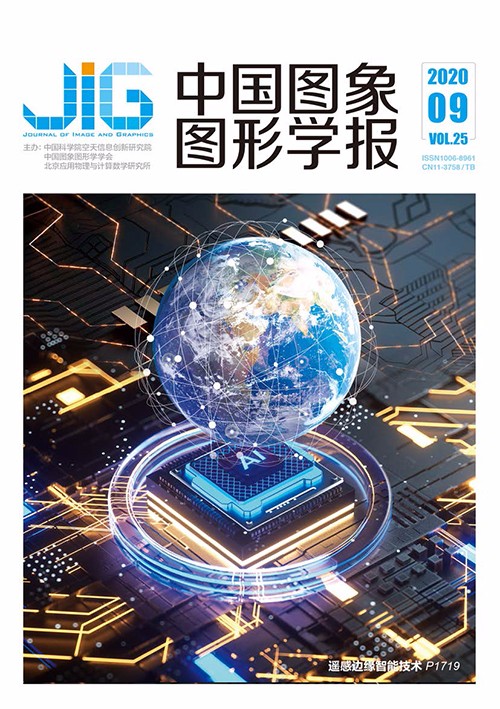
结合GAN的轻量级模糊车牌识别算法
摘 要
目的 模糊车牌识别是车牌识别领域的难题,针对模糊车牌图像收集困难、车牌识别算法模型太大、不适用于移动或嵌入式设备等不足,本文提出了一种轻量级的模糊车牌识别方法,使用深度卷积生成对抗网络生成模糊车牌图像,用于解决现实场景中模糊车牌难以收集的问题,在提升算法识别准确性的同时提升了部署泛化能力。方法 该算法主要包含两部分,即基于优化卷积生成对抗网络的模糊车牌图像生成和基于深度可分离卷积网络与双向长短时记忆(long short-term memory,LSTM)的轻量级车牌识别。首先,使用Wasserstein距离优化卷积生成对抗网络的损失函数,提高生成车牌图像的多样性和稳定性;其次,在卷积循环神经网络的基础上,结合深度可分离卷积设计了一个轻量级的车牌识别模型,深度可分离卷积网络在减少识别算法计算量的同时,能对训练样本进行有效的特征学习,将特征图转换为特征序列后输入到双向LSTM网络中,进行序列学习与标注。结果 实验表明,增加生成对抗网络生成的车牌图像,能有效提高本文算法、传统车牌识别和基于深度学习的车牌识别方法的识别率,为进一步提高各类算法的识别率提供了一种可行方案。结合深度可分离卷积的轻量级车牌识别模型,识别率与基于标准循环卷积神经网络(convolutional recurrent neural network,CRNN)的车牌识别方法经本文生成图像提高后的识别率相当,但在模型的大小和识别速度上都优于标准的CRNN模型,本文算法的模型大小为45 MB,识别速度为12.5帧/s,标准CRNN模型大小是82 MB,识别速度只有7帧/s。结论 使用生成对抗网络生成图像,可有效解决模糊车牌图像样本不足的问题;结合深度可分离卷积的轻量级车牌识别模型,具有良好的识别准确性和较好的部署泛化能力。
关键词
Lightweight blurred car plate recognition method combined with generated images
Duan Bin, Fu Xiang, Jiang Yi, Zeng Jiexian(School of Software, Nanchang Hangkong University, Nanchang 330063, China) Abstract
Objective Blurred car license plate recognition is a bottleneck in the field of license recognition. The development of deep learning brings a new research direction for license recognition. Benefitting from the superfeature extraction power of convolutional neural network (CNN) and the good context learning capacity of convolutional recurrent neural network (CRNN), the procedure of license recognition changes from a segmentation-based to an end-to-end method. Cur-rent deep learning-based license recognition methods suffer from two major problems. First, the size of the model is too large compared with traditional algorithms. In many applications, license recognition algorithms need to be deployed into embedded or mobile equipment. The generalization of algorithms is limited by its heavy size. Thus, keeping the balance between recognition efficiency and model size is challenging for license recognition methods based on deep learning. Second, the recognition effect of deep learning-based methods rely on large datasets, whereas the training dataset cannot be used widely because the car license formats vary in different countries. Collecting numerous car plate images manually is difficult in each country, let alone collecting blurred license images. Thus, the lack of training images is another challenge for deep learning-based license recognition methods. In this study, a lightweight car license plate recognition method is proposed. Car license plate images generated by optimized deep convolutional generative adversarial networks (DCGAN) are used to solve the problem of a lack of training dataset. The method simultaneously increases recognition accuracy and improves the generality of the model. Method The method includes two parts, namely, blurred car license image generation based on optimized DCGAN and lightweight car license plate recognition based on the depth of separable convolution networks with bidirectional long short-term memory (LSTM). In the first part, Wasserstein distance is used to optimize DCGAN and improve the diversity and stability of generated blurred images. Usually, generative adversarial networks (GAN) are designed to generate images with high quality; it is seldom used to generate images with low quality. Car license images are difficult to collect for format diversity and privacy reasons. In this study, GAN is used to generate images with low quality, that is, blurred car license images, to fill the training dataset and train deep models of license recognition. In the second part, a lightweight license recognition model is designed on the basis of deep separable convolution. Based on CRNN, the deep separable convolution operation can not only reduce the computation of recognition algorithms but also learn the features of training samples effectively. Lastly, the feature graphs are converted into feature sequences and input into bidirectional LSTM for sequence learning and labeling. Result Experimental results show that the proposed method is effective. First, by adding the generated blurred license images of DCGAN into the training dataset, recognition accuracy can be improved effectively, not only for the proposed method but also for the traditional method and other deep learning-based methods. Using generated image is a feasible scheme for all kinds of methods to improve their recognition accuracy. Second, by combining deep separable convolution layers with CRNN, the size of the recognition model is reduced, and the computation speed is improved effectively; furthermore, recognition accuracy is guaranteed. The proposed lightweight blurred car plate recognition model has a similar recognition accuracy with CRNN-based methods after improving its performance by using generated images in this research. By contrast, the size and recognition speed of the model are better than those of the CRNN model. For the proposed method, the size and recognition speed of the model are 45 MB and 12.5 frame/s, respectively; for the CRNN-based method, the values are 82 MB and 7 frame/s, respectively. The high recognition accuracy and small size of the model improve its possibility for application into mobile or embedded equipment. Conclusion The problem of lack blurred license images can be solved by using generated GAN images. Moreover, the lightweight license recognition model, which is improved with deep separable convolution, has high recognition accuracy and generalization performance.
Keywords
blur car license plate recognition deep learning generative adversarial network (GAN) deep separable convolution convolutional recurrent neural network (CRNN)
|



 中国图象图形学报 │ 京ICP备05080539号-4 │ 本系统由
中国图象图形学报 │ 京ICP备05080539号-4 │ 本系统由